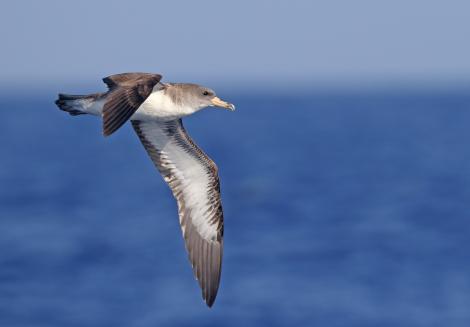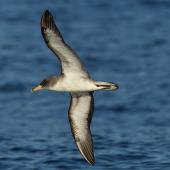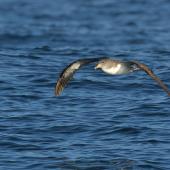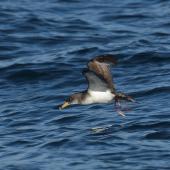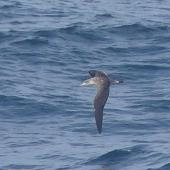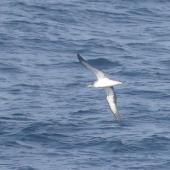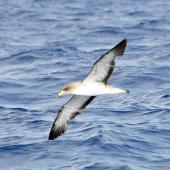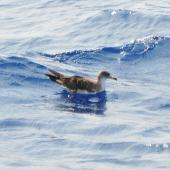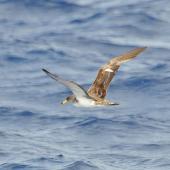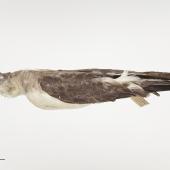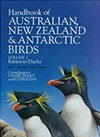Cory's shearwater
Calonectris borealis (Cory, 1881)
Order: Procellariiformes
Family: Procellariidae
Other names: North Atlantic shearwater, Mediterranean shearwater, Corys shearwater
Geographical variation: Previously considered conspecific with North Atlantic shearwater C. diomedea.
Cory’s shearwaters breed far from New Zealand, on islands in the temperate North Atlantic Ocean. In the non-breeding season they migrate to the South Atlantic Ocean off Brazil, Uruguay and Argentina and off South Africa in both the Atlantic and Indian Oceans. They do not often stray further, but one was presumably caught up in the prevailing westerly winds and swept into the Tasman Sea where it died and was washed ashore on the Manawatu coast in January 1934. It remains the only record for New Zealand and none has been found in Australia yet.
Identification
Cory’s shearwater is a large, heavy bodied shearwater, greyish brown above, on the face to below the eye and on the sides of the neck. The under surfaces are clean white except for the blackish tail and flight feathers. The bill is horn-yellow with a dark tip, and the feet vary from pink to dark.
Voice: Cory’s shearwaters are silent at sea.
Similar species: there are several other large grey-backed-and-white-bellied petrels that may occur in the New Zealand region; the large yellowish bill is a useful distinguishing mark of Cory’s shearwater. Buller’s shearwater is strongly patterned in two tones of brown and grey above, and has a dark bill. Grey petrel has dark underwings and a greenish bill. Streaked shearwater is similar to Cory’s shearwater but has a pale head, streaked white and dark. Pale morph wedge-tailed shearwater is slimmer and longer-tailed, with a much finer, dark bill. Great shearwater has a pronounced cap, contrasting with a pale nape, and has patches of dark feathers on the belly and under-wing, and a dark bill. Pink-footed shearwater is the most similar to Cory’s shearwater, but has dark undertail coverts and usually has some or extensive dusky markings on the flanks and underwing.
Distribution and habitat
Cory’s shearwaters breed on islands off Portugal, the Azores, Madeira and Canary Island groups. From November to May, non-breeding birds are found in the South Atlantic Ocean offshore from Brazil, Uruguay and Argentina and in the vicinity of southern Africa including the Indian Ocean occasionally as far as Amsterdam and St Paul Islands. They are pelagic in temperate water 16°C or warmer, coastal to offshore.
New Zealand records
The sole New Zealand record was a bird found dead on Foxton Beach in January 1934, and preserved in Te Papa (specimen registration no. OR.000234).
Threats and conservation
Cory’s shearwater is a very common species estimated as having a population from 600,000 to 1,200,000, thought to be in gradual decline.
Behaviour and ecology
An easy flier on broad wings, Cory’s shearwater may appear relaxed in flight but it moves fast in long glides, interspersed by a few deep, powerful wing beats. They usually stay close to the surface but may rise higher in strong winds.
Cory’s shearwaters often form flocks of up to about 100 birds, sometimes with other seabird species. They are attracted to offal.
Food
Cory’s shearwaters consume fish and squid taken from the surface or by shallow dives, occasionally to 15 m.
Websites
References
Harrison, P. 1983. Seabirds, an identification guide. Croom Helm Ltd., Kent.
Marchant, S.; Higgins, P.J. (eds.), 1990. Handbook of Australian, New Zealand and Antarctic birds. Vol 1, ratites to ducks. Oxford University Press, Melbourne.
Oliver, W.R.B. 1934. Occurrence of the Mediterranean shearwater in New Zealand. Emu 34: 23-24.
Onley, D.; Scofield, P. 2007. Field guide to the albatrosses, petrels and shearwaters of the world. Christopher Helm, London.
Recommended citation
Southey, I. 2013. Cory’s shearwater. In Miskelly, C.M. (ed.) New Zealand Birds Online. www.nzbirdsonline.org.nz
Cory's shearwater
- Breeding season
-
- Jul
- Aug
- Sep
- Oct
- Nov
- Dec
- Jan
- Feb
- Mar
- Apr
- May
- Jun
- Egg laying dates
-
- Jul
- Aug
- Sep
- Oct
- Nov
- Dec
- Jan
- Feb
- Mar
- Apr
- May
- Jun




